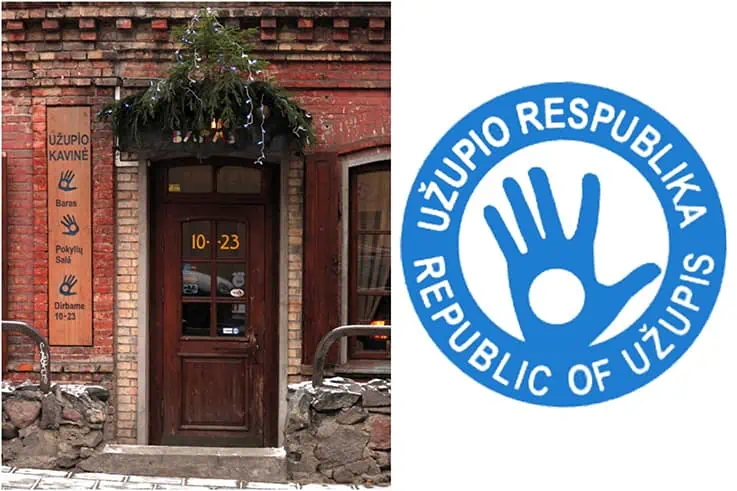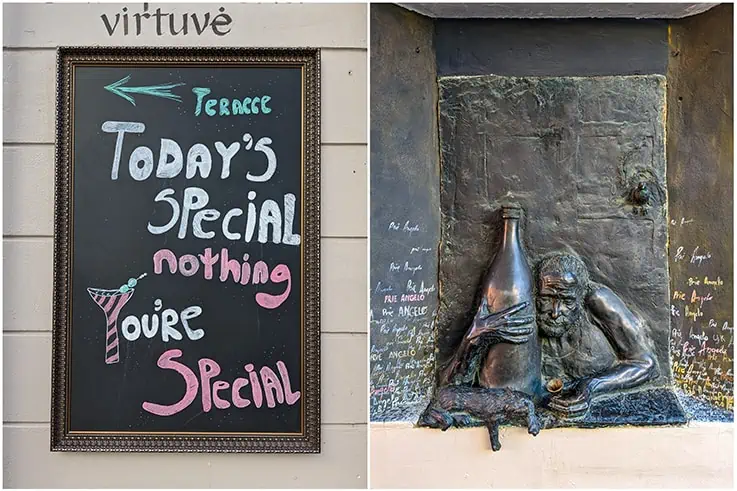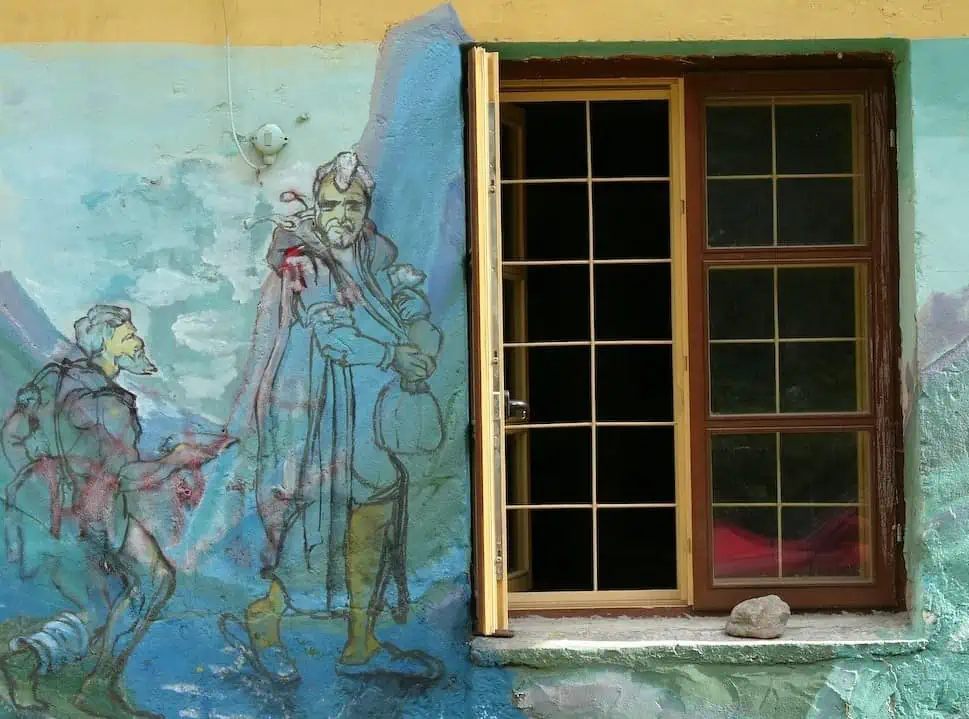
Once home to the ominously named “Street of Death”, the small area of Užupis in the east of Vilnius has completely reinvented itself since the mid to late-20th century. Emerging from the turbulence of World War II and the subsequent Soviet occupation, this tiny corner of the world became a hub for creatives, declaring itself an independent republic in 1997, with its own anthem, flag, constitution and currency. Now home to around 7,000 residents, 1,000 of whom are artists, the neighbourhood remains committed to an alternative lifestyle, notwithstanding the new challenges posed by gentrification and urban development.
Meaning “beyond the river”, Užupis is one of the oldest districts in Vilnius, dating back to the 15th century. However, few relics remain from that time because of its troubled history. Formerly a Jewish community, the horrors of the Holocaust during the Nazi occupation of Vilnius hit Užupis particularly hard, with the majority of its citizens deported or sent to concentration camps.
Post-war, the area rapidly declined during the Soviet occupation and abandoned buildings were taken over by criminals, prostitutes and the homeless. The “Street of Death” moniker reflected not only the dangerous nature of the derelict area but also the decimation of its former residents.
It was a dark time in Vilnius’ history but following Lithuania’s declaration of independence from the USSR in 1990, a spark of light began that has continued to grow and now burns brightly throughout all 148 acres (0.6 km2) of this vibrant neighbourhood.
After breaking away from the USSR, Vilnius was keen to remove as many traces of the occupation as possible, meaning that former Soviet icons were torn down. Artists from Užupis saw this as an opportunity to erect their own icons on the now-empty plinths, symbolising a new era of freedom and democracy.
The “Frank Zappa Fan Club” managed to convince local authorities that despite Zappa never visiting Lithuania, his vaguely Jewish features merited him getting his own statue in the city centre and in 1995, their dream became a reality when their patron saint was immortalised in bronze in downtown Vilnius. While the statue itself is not in Užupis, its erection is considered a victory for the area’s creative residents and it prompted the development of Užupis’ larger artistic endeavours.
Fundamental amongst these initiatives was the foundation of an art community and open-air gallery in 1996 in a once-derelict factory beside the Vilnelė river. Initially home to squatters who were not accepted in Lithuania’s conventional art scene, the project gained the support of the local authority to become the Užupis Art Incubator in 2002, complete with artists’ studios and ever-changing art installations.
Some of the more famous of these include a backpacking Jesus and an old broken-down piano. A souvenir shop beside the Art Incubator offers various artworks for sale, as well as copies of the Užupis constitution and the opportunity to get a passport stamp for the Republic of Užupis.
Following the success of what was to become the Art Incubator, two of the original squatters, Romas Lileikis (now President) and Thomas Čepaitis (now Foreign Minister), decided to take their ideals one step further. On 1 April 1997, they created the independent Republic of Užupis with its own flag, president, cabinet of ministers, anthem and initially an army of 11 men, though this was retired in 1999. Its own constitution and currency followed soon after. Although it allegedly began as an April Fools’ joke between the two friends, it quickly evolved into a way of life for local residents, helping to support the community by attracting more visitors.
In line with the micro-state’s relaxed attitude towards government, the Užupio Kavine (Užupis café) has been the central meeting place of the parliament since its inception and it is said the constitution was penned here in just 3 hours in 1998. Affectionately known as Barliament, this is where ministers and ambassadors are appointed and strategies are developed to build ties with other nations. Elected officials perform slightly different roles in Užupis: ambassadors are responsible for various realms such as hummingbirds, poetry, the elements or whistling in the streets.

The unassuming “Barliament” and the Užupis flag
photography by: Lee Fenner / Flickr and Jens Pattke / Wikimedia Commons
Once the idea of an independent republic started to take root amongst the citizens of Užupis, Lileikis and Čepaitis decided it was time to clearly set out the canons of living in such a place. Born from Aristotle’s philosophy that any great city should have a limited number of inhabitants so that everyone knows everyone else, the founding fathers wanted the Užupis constitution to reflect this commitment to neighbourly behaviours, freedom of expression and connection amongst all living creatures.
The 41 clauses therefore include such points as “Everyone may share what they possess”; “Everyone has the right to be undistinguished and unknown”; and “Everyone has the right to celebrate or not celebrate their birthday”. With Lileikis being a dog-lover and Čepaitis a cat-lover, “A dog has the right to be a dog” and “A cat is not obliged to love its owner, but must help in time of need” also form part of the legislation.
The charter was made a public installation in 2003, when mirrored plaques of the articles were hung in Lithuanian and English along Paupio Gatve. The Avenue of Constitutions continues to grow, with over 40 languages now represented including Yiddish, Sanskrit and Gaelic. The Latin plaque was even blessed by Pope Francis himself during his visit to the Baltics in 2018.
Each year, Užupis Day is celebrated on 1 April, the only day when the border with the rest of Vilnius is officially manned. Travellers can get their passports stamped as they cross the bridge into the republic, spend any local currency they might have (1 EuroUžas (EUZ) will get you 1 pint of beer) and enjoy local brew directly from the spout of an old fountain underneath the statue of the Angel of Užupis, which flows from morning until night.
Other notable Užupean holidays include “White Tablecloth Day”, the day after Easter when everyone brings Easter leftovers to white-covered tables on terraces along the Vilnelė river; and “Firewood Market”, the second Saturday in December when firewood and other donated items are distributed to the poor in the old Užupis marketplace.
These holidays are designed to be enjoyed by all residents and perhaps encourage visitors to become citizens themselves. The only criteria needed for this is to have visited Užupis at least once in a lifetime and to loudly declare citizenship. Užupean passports or ID cards are similarly informal – the official website somewhat cheekily suggests that if such a document is desired, it will be unique as you can draw it yourself!

Bar art in Užupis
photography by: Sinéad Browne
It is clear that symbolism plays an important role in Užupis and nowhere is this more evident than in the country’s flag. On a white background sits the “Holy Hand”, a blue hand with a hole in the middle, representing the integrity of the citizens of Užupis: they have nothing to hide in their hands and cannot be bribed or appropriated. While the blue flag is most common, seasonal flags show the palm emblem in different colours: green for spring, yellow for summer and red for autumn.
Perhaps the most famous symbol of Užupis is its bronze statue of the Archangel Gabriel blowing a trumpet. It was erected in 2002 as a symbol of growth and rebirth, replacing a former statue called “The Egg”, which now resides on Pylimo Street.
Romantic locals like to say that the Angel was hatched from the egg, with his trumpet heralding a new free-thinking age for the nation. The real reason for the statue is to perpetuate the legacy of the artist Zenonas Šteinis, an active member of the community who is considered the guardian angel of Užupis, helping it to transform into today’s creative haven.
Interestingly, the sculptor of the Angel of Užupis, Romas Vilčiauskas, also created a less well-known artwork by the name of Mermaid of Užupis. She is located on the banks of the Vilnelė river, across from Užupio Kavine, and legend has it that she lures visitors in with her charms rendering them unable to leave.
She almost left Užupis herself once, being swept away in a flood in 2004 but thankfully she was found and restored to her waterside perch. She is easily visible from the café or if river levels permit, from the Swing of Destiny under Užupis Bridge.
Beyond its numerous statues and artworks, Užupis has a number of cultural and historical points of interest for curious travellers. Perhaps the first to grab visitors’ attention is the welcome sign next to the Bridge of Užupis near Maironio Gatve. Beneath the words “Užupio Res Publika”, there are 4 icons: a smiley face encouraging tourists to grin happily; a circled speed limit requesting a slow pace while exploring; the Mona Lisa as a reminder that this is an art district; and a car falling into the river meaning that you are now beyond the river, the direct translation of the word Užupis.
A short walk from the bridge lies Tibet Square, opened in 2010. A mandala sculpture was unveiled in the square by the Dalai Lama himself on his second visit in 2013 and he was subsequently made an honorary citizen of Užupis, a tribute that was interpreted somewhat angrily by China as it was considered a political statement.
One of Užupis’ spookier attractions is the Bernadine Cemetery, established in 1810 and housing over 14,000 burial sites. What makes it especially creepy is the photos of the deceased alongside the gravestones: in the Victorian era, it was fashionable to dress up deceased family members for a photoshoot to preserve their memory. To add to this ethereal atmosphere, shallow graves mean that in springtime, bones can sometimes be seen protruding out of the ground.
While the ideals and idiosyncrasies of a society such as Užupis may sound idyllic to many people, such freedom does not come without a cost. In recent years, it has become one of the most desirable places to live in Vilnius, a far cry from its destitute past. Gentrification and urban development have caused property prices to spike, meaning that the artists who are the area’s true founders can no longer afford to buy or even rent property there.
Some ministers are concerned about the effect this will have on the culture and way of life. However, others argue that such change is inevitable and for the good of society, promoting equitable standards further afield. As per article 22 of the Constitution, only time will tell and “No one has the right to have a design on eternity”.

Street art in Užupis
photography by: Julio Gago/ Flickr
In its darkest era, crossing the bridge into Užupis would have been considered either very brave or very foolish. Nowadays, even the bridges are welcoming to tourists, with flowers and love locks along their railings and quaint cobbled streets awaiting explorers on the other side.
Užupis is easily accessed from any part of the city, located just east of the Old Town and close to landmarks such as St Anne’s Church, the Bernadine Gardens, and the City Bastion. The Užupis website has an interesting slideshow showing historical pictures of the nine bridges of Užupis.

Love locks on Užupis Bridge
photography by: Lee Fenner/ Flickr
The best way to discover Užupis is definitely to visit and chat to the locals in person. For those who really want to delve into the history before visiting, the official website will give you some great conversation starters, with tongue-in-cheek humour peppered throughout. Užupis even has its own YouTube channel with a few hundred subscribers, with videos featuring notable local artists and festivals.